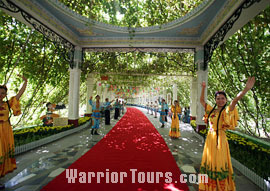Turpan Introduction
 Turpan, which means 'Rich and Fertile Land' in Turki literally, is reputed as the 'Hometown of Grapes'. It is situated in the low Turpan Basin of the middle Xinjiang Uygur Autonomous Region, and is separated from the capital city Urumqi by the enthralling and mysterious Heavenly Mountain (Tianshan) in the north. In its south lies the great Takla Makan Desert, the second largest desert in the world. For years, this magical and pretty city has attracted many visitors to Xinjiang.
Turpan, which means 'Rich and Fertile Land' in Turki literally, is reputed as the 'Hometown of Grapes'. It is situated in the low Turpan Basin of the middle Xinjiang Uygur Autonomous Region, and is separated from the capital city Urumqi by the enthralling and mysterious Heavenly Mountain (Tianshan) in the north. In its south lies the great Takla Makan Desert, the second largest desert in the world. For years, this magical and pretty city has attracted many visitors to Xinjiang.
![]() How to Get to/around Turpan
How to Get to/around Turpan
Known as 'the Fire Land', Turpan is the hottest place in China. During the fervent months of June, July and August, the average temperature here is over 38 ? (100.4 ?). The high temperatures also last the longest here. The area has a warm temperate arid desert climate. However, with its abundant light and heat, this area yields productive harvests of grapes, Hami melons, cottons and rare unseasonable vegetables and other economic plants. When the harvest time comes, the savory sweet fruits and melons can make anyone lick his lips in anticipation.
The unique climate and location of Turpan has given rise to many majestic natural wonders here. Strolling in the Aydingkol Lake, the second lowest point in the world, you might feel as if you were touching the bottom of a sea. The mysterious Flaming Mountain in Journey to the West, one of the four famous Chinese classical works, is actually the hottest place across China; while in the nearby Grape Valley, it is possible to enjoy the eyeful of grapes as well as cool yourself. The ample fruits here owe much to the irrigation project, Karez System, which is considered one of the three greatest ancient projects eponymous with Great Wall and Grand Canal in China.

![]() Karez System
Karez System
The Karez System is an ancient irrigation system, referred to as one of the 'Three Great Ancient Project of China' along with The Great Wall and Grand Canal. The history of the Karez can be traced back some 2,000 years, even today, there are still thousands of Karez running under Xinjiang, though most of them are under the Turpan. Turpan is an area where annual rainfall is low, and surface water evaporates quickly. To survive in this harsh environment, ancient people used a system consists of underground canals accessed by wells, over-ground canals and small reservoirs to irrigate the Turpan desert. They channeled the melting snow from Tian Shan Mountain into the Karez, thus many oases appeared in the desert, including the famous Grape Valley. Thanks to the ingenuity of these ancient people, Turpan became the birthplace of grapes, hami melons, cotton, and many other fruits and vegetables.
Admission Fee: CNY15
![]() Sand Therapy Center
Sand Therapy Center
Sand therapy is very effective at alleviating the symptoms of arthritis, rheumatism, lumbago and skin diseases. The Sand Therapy Center lies 16 km (10 miles) northwest of Turpan City and is where most Turpan people and visitors alike take sand therapy. People lie or sit buried under the baking hot magnetite sand during summer, especially from between mid June and August. The center also provides treatment rooms, wards and canteens for both patients and visitors.
Admission Fee: CNY10
Opening Times: From Middle of June to September
Turpan was also one of the fortresses in the well-known ancient Silk Road and the economic and cultural hinge between inner land of China and western regions and other Asian countries. The reserved mysterious historical and cultural relics attest to the prosperity that the city had experienced. The well preserved Ancient City of Jiaohe and Ancient City of Gaochang are both thousands of years old and the capital cities of the once flourishing kingdoms here. In addition, the called 'Underground Museum', Astana-Karakhoja Ancient Tombs, Ancient City of Jiaohe, Bizaklik Thousand Buddha Caves with exquisite murals and the Islamic architecture - Emin Minaret are all the invaluable treasures left by history.
Turpan is also one of the cultural centers of the Uygur ethnic groups. Uygur people constitute more than 70% of the total population there. The local Uygur music, dances, dressings, food, customs and architectures are all characteristic and worth of appreciation. In every August, a 'Grape Festival' is held involving many colorful activities such as singing and dancing performances, summer parties, tasting famous local wines, opening special streets of snacks as well as grapes and melons. Guanghui Street is a famous street for local snacks. For shopping you can also go to Turpan General Merchandise Building and Turpan Old City Free Market of Agricultural Products. Raisins and Uygur flowery hats can be bought as souvenirs.